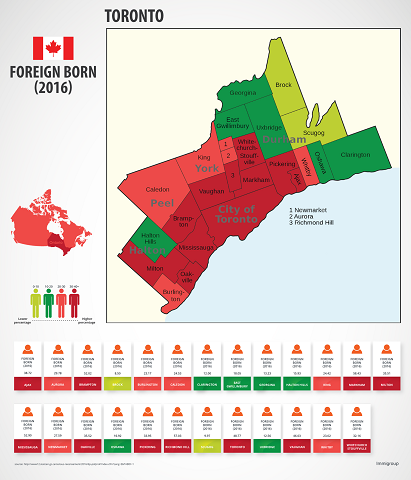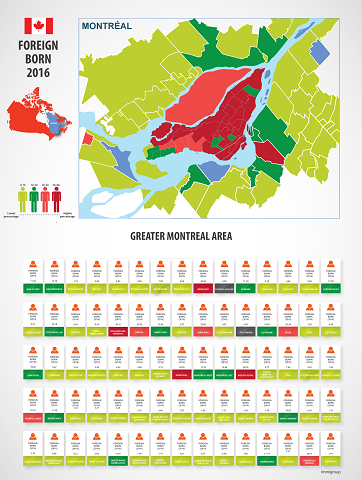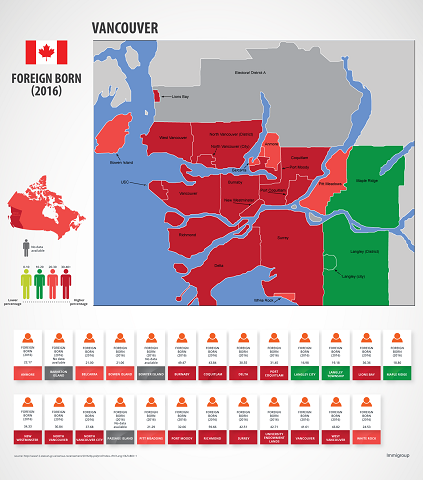What Happens When Immigration to Canada Stops?

Don’t like immigration? Think immigrants are ruining the country? Think again.
Updated for 2018
At some point in the near future, Chinese, Indian and other immigrants to Canada will start going home in serious numbers. Reverse immigration has already been happening for a number of years, especially among NRIs (people of Indian origin) living in Canada. And some Chinese-Canadians spend as much time in China as they do in Canada, taking care of business. And that matters because China and India together account for 36% of the world’s population. And as each country reaches further stages in their development, this will provide lots of opportunities for entrepreneurs to bring some of their worldly experience in places like Canada, back to their home countries.
Chinese Canadians [Public Domain]
Or they might not even bother coming to Canada in the first place. As India and China and other developing nations increase in terms of GDP per capita, and in terms of income, less people may be willing to move to countries like Canada. Why put in the time, effort, as well as pay the fees necessary to apply to immigrate to Canada, if the job opportunities at home are improving? It’s a question some are already asking, even if, for a large number of migrants, navigating the complexity of Canada’s immigration policy is still well worth the chance to live and work here.
So when might the taps run dry? Will the flow possibly reverse? Could we have more new Canadians deciding to return to their homeland than those few still trying to enter Canada? That depends on a few things:
- Reform in India: It all started in the early 1990s but the pace of reform is still less than hoped for. By both those inside the country and NRIs around the world casting a nostalgic or opportunistic eye back home. Corruption and rigid regulations still thrive in the South Asian giant.
- Reform in China: They have way more infrastructure than India, but they may be the next financial crisis waiting to explode. Debt levels, new construction that stands empty, and corrupt party officials, especially at the local level, are all serious obstacles. President Xi and his team must deal with each of them, without causing a serious recession or even a depression that would rock the world.
- Oil: Yes oil is as big a part of Canada’s 21st century economy as it has ever been. And when oil tanks we take it on the chin, and in our wallets. That means less growth and less jobs in immigration-friendly Alberta and Saskatchewan, for example. Of course low oil prices are great for India, which has to import tens of billions of dollars worth of energy products, oil and coal mostly, to keep the economy chugging along. And China is on the brink of becoming the world’s largest importer of oil. So low oil prices are great for the Chinese as well.
So let’s imagine that oil prices stay low, that India accelerates its reforms and spends on infrastructure the way China has for the last couple of decades, and that China itself avoids a debt meltdown and moves towards a more consumer-friendly economy. Wow. We should all be learning Hindi, Cantonese, or Mandarin, if these predictions are even half-right. Because if right now the world is obsessed with how China is doing, and keenly interested in India’s future, you haven’t seen anything yet.
Imagine over a third of the planet’s population seeing their incomes rise ever more dramatically. Far more than the increases in China and India in the last decade. Stop and imagine the sound of all those cash registers, or smart phone virtual wallets zinging away, as untold quantities of consumer goods and services get bought and sold in the Middle Kingdom and on the Subcontinent. Imagine you’re a 20-something MBA grad from York’s Business School who was born in Mumbai. Or a tech specialist in Toronto who hasn’t seen his hometown of Tianjin for a decade and whose cousin who stayed at home is a millionaire several times over. Where do you think you’ll be buying a ticket to? When you add the attraction of family and culture to the mix, then the supply of immigrants to Canada could dry right up. And some migrants will be heading back home, with or without their shiny new Canadian passport.
Make no mistake. Some will stay in Canada, because it’s the place they know and love best. From Tim Hortons at the hockey rink, to the best banking system in the world, to wide open countryside or bush an hour or less from most major cities. But many won’t stay, and Canada needs to envision policy responses to that. How will IRCC react? What might they change in their immigration policy to ensure Canada continues to be an attractive destination? Consider the following table that shows which countries send the most migrants to Canada:
| Country | Canadian Permanent Residents | |||||
|---|---|---|---|---|---|---|
| 2011 | 2012 | 2013 | 2014 | 2015 | 2015 | |
| China | 28,503 | 33,024 | 34,126 | 24,627 | 19,533 | 26,852 |
| India | 27,509 | 30,932 | 33,085 | 38,333 | 39,526 | 39,789 |
| Philippines | 36,765 | 34,314 | 29,539 | 40,032 | 50,827 | 41,791 |
| Pakistan | 7,468 | 11,227 | 12,602 | 9,114 | 11,329 | 11,337 |
In 2016, these top 4 source countries for immigrants contributed a total of 109,352 permanent residents, or 43% of all who gained permanent resident status in Canada in 2016 (up from 29% in 2013). China and India alone accounted for 22% (down from 26% in 2013).
Now consider the next table:
| country | Net Migration 2013-2017 |
Total Population (2018 est) |
Net Migration as a Percentage of Total Population |
|---|---|---|---|
| India | -2,449,998 | 1,354,051,854 | 0.18% |
| Pakistan | -1,071,778 | 200,813,818 | 0.53% |
| China | -1,624,595 | 1,415,045,928 | 0.11% |
| Philippines | -650,000 | 106,512,074 | 0.61% |
Source: https://data.worldbank.org/indicator/SM.POP.NETM
Source : https://en.wikipedia.org/wiki/List_of_countries_and_dependencies_by_population
The minus signs mean that these four countries have a net flow of migrants out of each country, as opposed to Canada, which has a net inflow of migrants into the country. What is also noticeable is that while the absolute numbers of migrants from each country are large, they are a fairly small percentage of the home country’s total population. This means that you don’t need huge changes in the economy of China or India, or Pakistan and Philippines, to dramatically affect their net migration numbers. And remember, the net migration numbers are for a 5 year period. So the annual net migration as a percentage of the total population is ⅕ of the percentages given above. It wouldn’t take an earth shattering pick-up in India’s economy to keep most of those net migrants at home. Or even less of a change in China. Pakistan and Philippines are less likely perhaps to undergo significant change that keeps their migrants at home, but change is coming down the road for these two countries as well.
Imagine that net migration from China and India dries up in a few years. And what is left has the usual suspects to choose from: Australia, New Zealand, the UK, the USA of course, and other countries in Europe like Germany. And Canada will have to compete with these countries for talented immigrants on a far greater level than it already does.
Maybe IRCC has these types of “doomsday” scenarios on hand and are planning for such an event. That seems unlikely, however, given the demanding and complex nature of Canada’s immigration policy with its changing rules and interpretations. It is likely that many new Canadians, and especially their children, will gladly remain in Canada even as conditions improve in their home countries, or their parent’s countries as the kids will likely put it. It’s the supply of new immigrants willing to come to Canada, however, that may just surprise us in the near future. Will Canada’s immigration policy be able to adapt? Can IRCC spell the word simplify?
Immigrants in Toronto
Immigrants in Montreal
![Chinese Canadians By Sgt. Karen M. Hermiston [Public domain or Public domain], via Wikimedia Commons](https://upload.wikimedia.org/wikipedia/commons/thumb/6/60/Chinese-Canadian_Soldiers-WW2.jpg/578px-Chinese-Canadian_Soldiers-WW2.jpg?uselang=en-gb)


